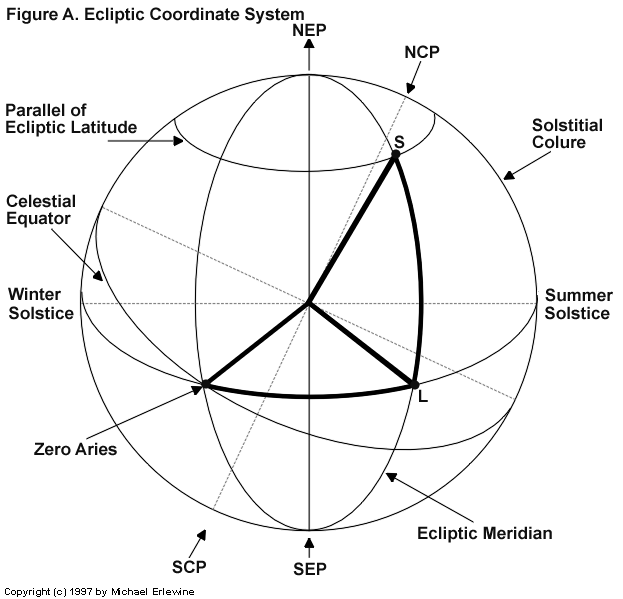The Astronomy of Eclipses:
An eclipse¹ is observed when a celestial body is seen to move in front of another. The Sun is eclipsed when the Moon passes in front of it. The Moon is eclipsed when the Earth casts its shadow on the Moon. The Galilean satellites of Jupiter eclipse one another. Some close binary stars are eclipsing binaries. The word eclipse is a general one; when the Moon moves in front of a star, however, the event is called an occultation, and when Mercury or Venus moves between the Earth and the Sun, the event is called a transit.
Eclipses of the Sun and Moon have long made a deep impression on humankind. The blotting out of light from a familiar and apparently predictable source was generally considered a bad omen. Predicting eclipses was one of the duties of ancient Chinese astronomers, who labored under the threat of death if they failed. Today eclipses can be predicted to within seconds, and interest in them is both scientific and aesthetic.
Partial, Total, and Annular Eclipses:
The shadow cast by a body has two components. In the case of the Moon, these are ----(1) the umbra cone with its apex an average of 373,000 km (231,700 mi) from the Moon, and in which the Sun is entirely obscured; and (2) the penumbraa region becoming wider the farther it is from the Moon, and in which the Sun is partially obscured.Since the average distance between the Earth and Moon is about 4,800 km (3,000 mi) greater than the length of the umbra, the tip of the umbra does not, on the average, quite reach the Earth's surface. But because of the eccentricity of the Moon's orbit, the Moon can come closer than average, and the umbra can intersect the Earth's surface in a circle with a diameter as great as 269 km (167 mi). As the umbra sweeps over the surface of the Earth, the longest time for a fixed observer to remain inside it is about 7 1/2 minutes. An observer within the umbra sees a total eclipse; one in the penumbra sees a partial eclipse. A solar eclipse is called annular when the tip of the umbra fails to reach the Earth; then only the center of the Sun is obscured, leaving a bright ring, or annulus.
An eclipse of the Moon can be total or partial, but not annular. It can be observed from any point on the Earth where the Moon would be visible. The Moon is never wholly dark during a lunar eclipse because of sunlight refracted by the Earth's atmosphere. The amount of indirect illumination depends on the atmospheric conditions at the time. Conditions for Occurrence
An eclipse of the Sun can take place only at new Moon, and that of the Moon only at full Moon; and the Sun, Earth, and Moon must be very nearly, if not precisely, aligned. Because the orbit of the Moon is inclined at about 5 degrees to the ecliptic, during most months new and full Moon will occur when the Moon is either too far north or south of the Sun for an eclipse to take place. But when the Sun is close to the ascending or descending node of the Moon's orbit, an eclipse is possible.
The Sun circles the ecliptic once a year; the Moon's ascending node moves in the opposite sense, taking 18.6 years for a circuit. The interval between successive passages of the Sun through the ascending node is called the eclipse year and is 346.6 days. Nineteen eclipse years is nearly the same as 223 synodic months (the interval between successive full moons, or 29.53 days). This period is called the saros and is equal to 18 years and 11.33 days (if the interval contains 4 leap years). After this interval a pattern of eclipses is repeated, but because of the partial 0.33 day, the repetition is displaced nearly 120 degrees in longitude. The saros was known to ancient Babylonian astronomers. . . .
One of the most famous tests of Einstein's theory of general relativity was made in 1919 during a solar eclipse. Einstein had predicted that a ray of light just grazing the surface of the Sun would change direction by 1.75 seconds of arc. The field of stars near the Sun was photographed during total eclipse; the same field had been photographed months earlier when it was in the night sky. The photographs were compared, and on this occasion, as well as on many similar occasions since, the observations were consistent with Einstein's prediction.
J. M. Anthony Danby
Bibliography: Abell, G., Exploration of the Universe, 4th ed. (1982); Link, F., Eclipse Phenomena in Astronomy (1969); Lowenthal, James, The Hidden Sun: Solar Eclipses and Astrophotography (1984); Meeus, J., et al., Canon of Solar Eclipses (1966); Menzel, D. H., Our Sun (1949); Mitchell, Samuel A., Eclipses of the Sun, 5th ed. (1951); Zirker, J. B., Total Eclipses of the Sun (1995).
Grolier's Encyclopedia CD ROM 1998
|


 The Ecliptic:
The Ecliptic:



